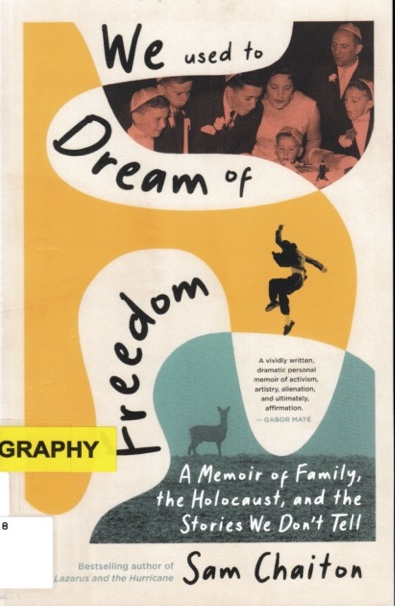Uncategorized
Memoir of child of Holocaust survivors takes riveting twists

Book Review by Julie Kirsh (former Sun Media News Research Director)
Exclusive to The Jewish Post
“We used to Dream of Freedom, A Memoir of Family, the Holocaust, and the Stories We Don’t Tell”
By Sam Chaiton (Dundurn Press) 2024
Sam Chaiton’s memoir of growing up with Holocaust survivor parents in downtown Toronto in the 1950s is a compelling read.
Jeanne Beker, a well known Toronto fashion writer, mentions in her praise for “We used to Dream of Freedom” that her survivor parents talked incessantly about their war experiences.
My own parents, both survivors, would drop tidbits of their stories now and again. I learned to be watchful and vigilant for these rare moments of revelation. However, questioning my parents about the Holocaust, would cause them pain. I knew when to stand down.
In his memoir, Sam Chaiton tells the reader that his parents chose to remain completely silent about their wartime experiences. Poignantly their son was left with a silence that he interpreted as huge empty sound. Although the son could understand some Yiddish, his parents turned to Polish in order to keep the “kinder safe”. Outright denial of illness and death was part of his parents’ way of coping.
Born in the 1950s on Palmerston Boulevard in downtown Toronto, Chaiton paints a vivid picture of his youth as the middle son of five boys. He describes the mayhem of a household of barked orders and punishment by his father’s belt. His mother, as with many other survivors, was obsessed with eating and food. Chaiton learned early that rejecting his controlling mother’s food was one of his few weapons. “It’s hard not to do what a Holocaust survivor wants you to”, he says. Chaiton had to stare down two parents both with tattoos.
Dance proved to be a saving grace for Chaiton. On the dance floor, with a partner, the gates of happiness and permission to be oneself, opened. The Toronto Dance Theatre in Yorkville was a salvation and home for Chaiton. Also important to Chaiton was a family – not his troubled blood family but a chosen one – a commune.
In 1973, after a sojourn in New York, Chaiton decided that he was not a performance dancer. Back in Toronto as he pointedly danced with his mother at his brother’s wedding, she told him that he was her favourite child, imposing “the psychological damage that parental favouritism caused”.
Living in a commune with a chosen family afforded Chaiton the freedom to dig deep into his psyche, face his traumatic upbringing and tear down the rigid rules of society and the biological family. At a certain point, for reasons he explains in the book, Chaiton made the decision to vanish from the lives of his parents and brothers.
In 1980 the commune took up the cause of the injustice and illegal jailing of Rubin “Hurricane” Carter. Carter had been exonerated, released from prison and then reconvicted and sent back to prison.
In hindsight Chaiton wonders if his disengagement from his family caused them the same wounds and feelings of emptiness that Carter had to face when he was reincarcerated.
In 1985 while sitting in a New Jersey prison yard with friends and Carter, Chaiton had the riveting vision that he was in a concentration camp, “on a mission to liberate (his) parents – the dream of every Holocaust survivor’s child.”
In the summer of 1985, Chaiton received the news from Toronto that his parents were involved in a fatal car accident. Only after his mother’s death, was Chaiton able to acknowledge that in spite of her smothering, she gave him a sense of self worth and strength.
In 1988 Chaiton co-wrote the story of freeing Carter. One of his brothers saw him on a news broadcast, contacted him and the 20-year silence between Chaiton and his blood family was over.
Riding on the coattails of the successful release of Carter, Chaiton and some friends established an organization that continues to exist today. Innocence Canada has helped wrongfully convicted people like Guy Paul Morin, David Milgaard and Steven Truscott.
In chapter 16, entitled Wierzbnik, Chaiton finally learns about his father’s testimony published in a book, “Remembering Survival”, by a university professor. Reading about his father’s history helped Chaiton to understand the damage done to survivors, his parents’ trauma and why the home that they created for their sons after the war was so fraught.
Chaiton remarks on the interconnectedness of learning about the sufferings of his parents, his own personal struggles and the gift his father left him of being able to tell his own story.
Sam Chaiton’s profound memoir took courage and brutal honesty to write.
His book teaches that the legacy left by Holocaust survivors, along with a deep sadness, is the innate need of the children to persevere and find their own path of survival and growth.
Uncategorized
NELLA MARGRITHE ESKIN NOVEMBER 14, 1946 – AUGUST 27, 2025

It is with great sorrow that the Eskin family reports the passing of Nella Margrithe Eskin, beloved wife and devoted partner of Michael Eskin, on August 27, 2025.
Nella, the only child of the late Kasiel and Rosa Kessler, Holocaust survivors, was born in a displaced persons camp in Fohrenwald, Germany, in 1946. The family first moved to Baltimore as refugees in 1949 before settling in Chicago, where Nella graduated from Roosevelt University with Bachelor of Science degree.
In 1969, she met Michael, and three months later they were married in Chicago in March 1970. They shared a wonderful marriage of over 55 years, during which they raised a family of four boys and created a home that was always full of song, food, guests and Yiddishkeit. Sadly, their eldest son, Katriel, passed away in 2015. Nella is survived by her other three sons, Josh, Ezra and Daniel, and their families as well as Katriel’s wife and family. She was a devoted wife, mother, and grandmother to her husband, sons, and ten grandchildren, and a loving daughter to her mother, Rosa, who passed away in 2020.
A lifelong scholar, she earned an MBA from the University of Manitoba in 1995. Nella was a very pious and learned woman who was also a wonderful artist, music lover, gardener and cook. She passed her love of music, art, storytelling and learning to her children, teaching each of them piano and instilling in them an enduring appreciation for the arts that continues to this day. She was an incredibly warm woman and made every gathering feel special, every guest feel valued, and every meal feel like a celebration of love and friendship.
She will be sorely missed by her husband, children, grandchildren, relatives in the UK, USA, Australia, and Israel, and many dear friends. Her kindness, curiosity, and love will live on in the many lives she touched. May her memory be
a blessing.
Uncategorized
VIDEO: Moishele Alfonso on the new book of I. L. Peretz stories for students
לכּבֿוד דער פּובליקאַציע פֿונעם ביכל „אויפֿן װעג: זיבן דערציילונגען פֿון י.־ל. פּרץ“ — אַ זאַמלונג ספּעציעל געמאַכט פֿאַר סטודענטן — קען מען איצט זען אַן אינטערוויו מיטן ייִדיש־לערער משהלע אַלפֿאָנסאָ, וואָס האָט פֿאַרקירצט און באַאַרבעט די דערציילונגען.
אין דעם אינטערוויו דערציילט אַלפֿאָנסאָ וועגן דעם פּראָצעס פֿון שאַפֿן דאָס ביכל, און לייענט געקליבענע אויסצוגן דערפֿון. דער אינטערוויו, געפֿירט פֿון אלי בענעדיקט, איז געשטיצט געוואָרן פֿון דער ייִדיש־ליגע, וואָס האָט אויך אַרויסגעגעבן דאָס לייענביכל.
דאָס נאָוואַטאָרישע ביכל גיט דעם לייענער אַ צוטריט צו קלאַסישע ייִדיש־דערציילונגען דורך אַ זײַט־בײַ־זײַטיקן גלאָסאַר, שמועס־פֿראַגעס און קלאַנג־רעקאָרדירונגען פֿון די מעשׂיות.
משהלע אַלפֿאָנסאָ איז אַ ייִדיש־לערער בײַם ייִדישן ביכער־צענטער זינט 2019. אין 2022 האָט ער, דורכן פֿאַרלאַג „אָלניאַנסקי־טעקסט“, טראַנסקריבירט און אַרויסגעגעבן יצחק באַשעוויסעס בוך „שׂונאים: די געשיכטע פֿון אַ ליבע“. דער ראָמאַן איז אַרויס אין המשכים אינעם פֿאָרווערטס אין 1966, און ס’איז דאָס ערשטע מאָל וואָס שׂונאים איז אַרויס אין בוכפֿאָרעם אויף ייִדיש.
דאָס ביכל קען מען באַשטעלן דאָ.
The post VIDEO: Moishele Alfonso on the new book of I. L. Peretz stories for students appeared first on The Forward.
Uncategorized
VIDEO: Peter, Paul and Mary’s “Light One Candle” — in Yiddish
If, like me, you enjoy listening to old recordings of the iconic folk group Peter, Paul and Mary, you may want to check this out: a new Yiddish version of their Hanukkah song “Light One Candle,” sung by another talented trio — Rabbi Avram, Elisha and Sarah Mlotek. (A transliteration of the lyrics appears beneath the video below.)
The three siblings are the grown children of Zalmen Mlotek, musician and director of the Yiddish National Theater Folksbiene, and his wife, Debbie Mlotek. Rabbi Avram is a writer, Elisha is a filmmaker and Sarah is studying music at a conservatory in Israel — and just became a mom.
Their singing is backed up by C. Joseph Lanzbom on guitar and Elisha on percussion.
The original song, which was written by Peter Yarrow, became an anthem for the Soviet Jewry movement in the 1980s, symbolizing their struggle for freedom. It was translated into Yiddish by the theater producer Moishe Rosenfeld and Avram Mlotek.
“‘Light One Candle’ was one of our Bubbe’s favorite songs every time we got together for a Hanukkah sing-along,” Avram said. Their Bubbe was the renowned scholar of Yiddish song, Chana Mlotek. For many years, she and her husband, the Yiddish cultural activist Yosl Mlotek, ran a column about Yiddish songs and poetry in the Forward.
Although Hanukkah is still a month away, Bubby Chana’s grandchildren had a meaningful reason for publishing it now: This week marks her yortzeit.
TRANSLITERATION
Eyn likht shaynt far di heldishe kinder
A dank vos dos likht geyt nit oys
Eyn likht shaynt far di payn un di laydn
Di sakone’z geven azoy groys
Eyn likht flakert far korbones un laydn
Az yoysher un frayhayt zol zayn
Eyn likhtl flakert far khokhme un visn
Far frayhayt un sholem zol zayn.
Lesht nit di likhtlekh oys!
Zey flakern shoyn doyres-lang
Lesht nit di likhtlekh oys!
Balaykhtn durkh undzer gezang!
Eyn likht flakert tsu gebn undz koyekh
Az eybik mir’n blaybn getray
Eyn likht flakert far mentshn vos laydn
Oykh mir zenen nisht geven fray
Eyn likhtl flakert far zise khaloymes
Tseteyln zol undz nisht der kas
Un eyn likhtl flakert tsu haltn tsuzamen
Mit sholem un mer nisht kayn has
Lesht nit di likhtlekh oys!
Zey flakern shoyn doyres-lang
Lesht nit di likhtlekh oys!
Balaykhtn durkh undzer gezang!
Vos iz di mayse vos iz azoy tayer
Vos lebt eybik in undzer flam?
Vos iz di shvue tsu fargangene doyres
Az es lebt undzer folk, undzer am?
Mir kumen, mir geyen, mir hofn, mir gloybn
Az yoysher vet vern der klal
Dos iz der viln, dos iz di shvue
A shenere velt iberal!
Lesht nit di likhtlekh oys!
Zey flakern shoyn doyres-lang
Lesht nit di likhtlekh oys!
Balaykhtn durkh undzer gezang!
The post VIDEO: Peter, Paul and Mary’s “Light One Candle” — in Yiddish appeared first on The Forward.




